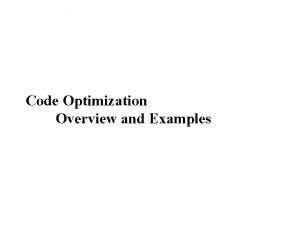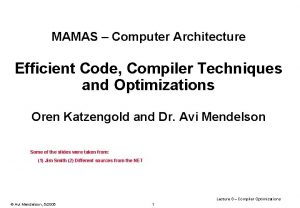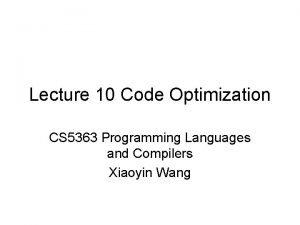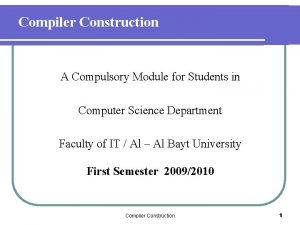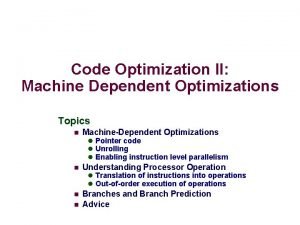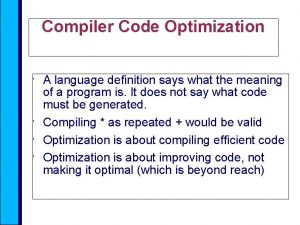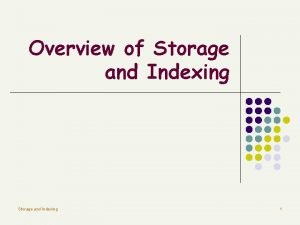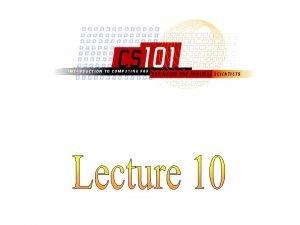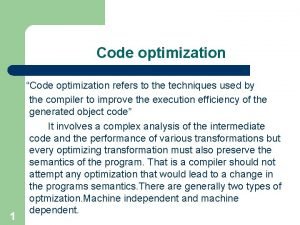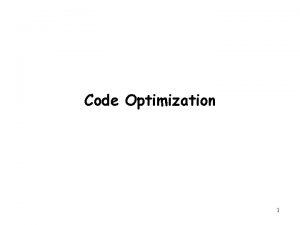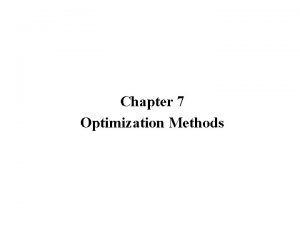Code Optimization Overview and Examples Code Optimization v















![Code Optimization Techniques v Loop fusion q Example for i=1 to N do A[i] Code Optimization Techniques v Loop fusion q Example for i=1 to N do A[i]](https://slidetodoc.com/presentation_image/31cac2011f9e6c09f1b81f31bf349792/image-16.jpg)


- Slides: 18

Code Optimization Overview and Examples

Code Optimization v Why q Reduce programmers’ burden § Allow programmers to concentrate on high level concept § Without worrying about performance issues v Target q Reduce execution time q Reduce space q Sometimes, these are tradeoffs v Types q Intermediate code level § We are looking at this part now q Machine code level § Instruction selection, register allocation, etc.

Code Optimization v Scope q Peephole analysis § Within one or a few instructions q Local analysis § Within a basic block q Global analysis § Entire procedure or within a certain scope q Inter-procedural analysis § Beyond a procedure, consider the entire program

Code Optimization v Techniques q Constant propagation q Constant folding q Algebraic simplification, strength reduction q Copy propagation q Common subexpression elimination q Unreachable code elimination q Dead code elimination q Loop Optimization q Function related § Function inlining, function cloning

Code Optimization Techniques v Constant propagation q If the value of a variable is a constant, then replace the variable by the constant § It is not the constant definition, but a variable is assigned to a constant § The variable may not always be a constant q E. g. N : = 10; C : = 2; for (i: =0; i<N; i++) { s : = s + i*C; } for (i: =0; i<10; i++) { s : = s + i*2; } If (C) go to … § The other branch, if any, can be eliminated by other optimizations q Requirement: § After a constant assignment to the variable § Until next assignment of the variable § Perform data flow analysis to determine the propagation

Code Optimization Techniques v Constant folding q In a statement x : = y op z or x : = op y q If y and z are constants q Then the value can be computed at compilation time q Example #define M 10 x : = 2 * M x : = 20 If (M < 0) goto L can be eliminated y : = 10 * 5 y : = 50 q Difference: constant propagation and folding § Propagation: only substitute a variable by its assigned constant § Folding: Consider variables whose values can be computed at compilation time and controls whose decision can be determined at compilation time

Code Optimization Techniques v Algebraic simplification q More general form of constant folding, e. g. , § x+0 x § x*1 x § x*0 0 x– 0 x x/1 x q Repeatedly apply the rules § (y * 1 + 0) / 1 y v Strength reduction q Replace expensive operations § E. g. , x : = x * 8 x : = x << 3

Code Optimization Techniques v Copy propagation q Extension of constant propagation q After y is assigned to x, use y to replace x till x is assigned again q Example x : = y; s : = x * f(x) s : = y * f(y) q Reduce the copying q If y is reassigned in between, then this action cannot be performed

Code Optimization Techniques v Common subexpression elimination q Example: a : = b + c c : = b + c d : = b + c a : = b + c c : = a d : = b + c q Example in array index calculations § c[i+1] : = a[i+1] + b[i+1] § During address computation, i+1 should be reused § Not visible in high level code, but in intermediate code

Code Optimization Techniques v Unreacheable code elimination q Construct the control flow graph q Unreachable code block will not have an incoming edge q After constant propagation/folding, unreachable branches can be eliminated v Dead code elimination q Ineffective statements § x : = y + 1 § y : = 5 § x : = 2 * z (immediately redefined, eliminate!) y : = 5 x : = 2 * z q A variable is dead if it is never used after last definition § Eliminate assignments to dead variables q Need to do data flow analysis to find dead variables

Code Optimization Techniques v Function inlining q Replace a function call with the body of the function q Save a lot of copying of the parameters, return address, etc. v Function cloning q Create specialized code for a function for different calling parameters

Code Optimization Techniques v Loop optimization q Consumes 90% of the execution time a larger payoff to optimize the code within a loop v Techniques q Loop invariant detection and code motion q Induction variable elimination q Strength reduction in loops q Loop unrolling q Loop peeling q Loop fusion

Code Optimization Techniques v Loop invariant detection and code motion q If the result of a statement or expression does not change within a loop, and it has no external side-effect q Computation can be moved to outside of the loop q Example for (i=0; i<n; i++) a[i] : = a[i] + x/y; § Three address code for (i=0; i<n; i++) { c : = x/y; a[i] : = a[i] + c; } c : = x/y; for (i=0; i<n; i++) a[i] : = a[i] + c;

Code Optimization Techniques v Strength reduction in loops q Example s : = 0; for (i=0; i<n; i++) { v : = 4 * i; s : = s + v; ) s : = 0; for (i=0; i<n; i++) { v : = v + 4; s : = s + v; ) v Induction variable elimination q If there are multiple induction variables in a loop, can eliminate the ones which are used only in the test condition q Example s : = 0; for (i=0; i<n; i++) { s : = 4 * i; … } -- i is not referenced in loop s : = 0; e : = 4*n; while (s < e) { s : = s + 4; }

Code Optimization Techniques v Loop unrolling q Execute loop body multiple times at each iteration q Get rid of the conditional branches, if possible q Allow optimization to cross multiple iterations of the loop § Especially for parallel instruction execution q Space time tradeoff § Increase in code size, reduce some instructions v Loop peeling q Similar to unrolling q But unroll the first and/or last few iterations
![Code Optimization Techniques v Loop fusion q Example for i1 to N do Ai Code Optimization Techniques v Loop fusion q Example for i=1 to N do A[i]](https://slidetodoc.com/presentation_image/31cac2011f9e6c09f1b81f31bf349792/image-16.jpg)
Code Optimization Techniques v Loop fusion q Example for i=1 to N do A[i] = B[i] + 1 endfor i=1 to N do C[i] = A[i] / 2 endfor i=1 to N do D[i] = 1 / C[i+1] endfor Before Loop Fusion for i=1 to N do A[i] = B[i] + 1 C[i] = A[i] / 2 D[i] = 1 / C[i+1] endfor Is this correct? Actually, cannot fuse third loop

Code Optimization v Will cover a subset of the techniques q Control flow graph § To facilitate data flow analysis for optimization § To facilitate loop identification q Data flow analysis § Reachability analysis, copy propagation, expression propagation § Constant folding § Liveliness analysis, dead code elimination q Loop optimization q Function optimization q Alias analysis (pointers) § Depend on the time, some topics may be skipped

Code Optimization -- Summary v Read Section 9. 1
 Code optimization techniques
Code optimization techniques Code commit code build code deploy
Code commit code build code deploy Code optimization techniques
Code optimization techniques Peephole optimization is machine dependent
Peephole optimization is machine dependent Phases of compiler construction
Phases of compiler construction Machine dependent code optimization example
Machine dependent code optimization example Code optimization definition
Code optimization definition Perbedaan replikasi virus dna dan rna
Perbedaan replikasi virus dna dan rna Data quality and data cleaning an overview
Data quality and data cleaning an overview Elements and their properties section 1 metals answer key
Elements and their properties section 1 metals answer key Chicago time
Chicago time Multicullar
Multicullar An overview of data warehousing and olap technology
An overview of data warehousing and olap technology Data quality and data cleaning an overview
Data quality and data cleaning an overview Data quality and data cleaning an overview
Data quality and data cleaning an overview Overview of storage and indexing
Overview of storage and indexing Elements and their properties section 1 metals
Elements and their properties section 1 metals Difference between source code and machine code
Difference between source code and machine code What is code mixing
What is code mixing
